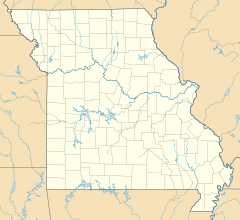Bellefontaine Cemetery

The Wainwright Tomb at Bellefontaine Cemetery is listed on the National Register of Historic Places.
|
|
| Location of Bellefontaine Cemetery | |
| Details | |
|---|---|
| Established | 1849 |
| Location | 4947 West Florissant Avenue St. Louis, Missouri |
| Country | United States |
| Coordinates | 38°41′27″N 90°14′06″W / 38.69095°N 90.23494°W |
| Type | Public |
| Size | 314 acres (127 ha) |
| No. of graves | 87,000 |
| Website | bellefontainecemetery |
| Find a Grave | Bellefontaine Cemetery |
Bellefontaine Cemetery is a nonprofit, non-denominational cemetery and arboretum located in St. Louis, Missouri. Founded in 1849 as a rural cemetery, Bellefontaine is home to a number of architecturally significant monuments and mausoleums such as the Louis Sullivan-designed Wainwright Tomb, which is listed on the National Register of Historic Places. The cemetery contains 314 acres (1.27 km2) of land and over 87,000 graves, including those of William Clark, Adolphus Busch, Thomas Hart Benton, and William S. Burroughs. Many Union and Confederate soldiers from the American Civil War are buried at Bellefontaine, as well as numerous local and state politicians.
On March 7, 1849, banker William McPherson and lawyer John Fletcher Darby assembled a group of some of St. Louis’s most prominent citizens to found the Rural Cemetery Association of St. Louis. This association sought to respond to the needs of a rapidly growing St. Louis by establishing a new cemetery several miles outside city limits. St. Louis was experiencing exponential population growth during this time and city leaders thought that the existing graveyards, which were mostly concentrated along Jefferson Avenue near the city center, were an impediment to urban development. Many were also convinced that city cemeteries represented a public health hazard (see miasma theory). These problems were compounded during the summer of 1849, when a massive cholera epidemic swept through St. Louis and claimed the lives of more than 4,000 people. With existing cemeteries running out of space to expand, and with many residents fearing that fumes from nearby cemeteries could cause them to fall ill en masse once again, this epidemic further underscored the need for a new rural cemetery for St. Louis.
...
Wikipedia

